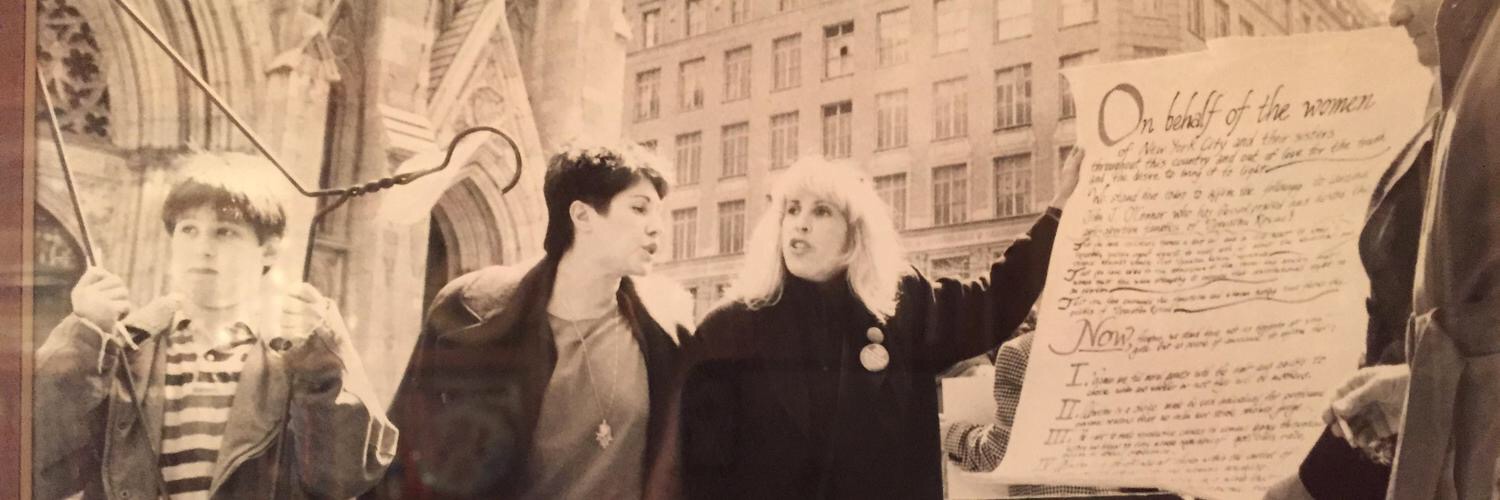
The Supreme Court will hear the most significant abortion case in years today. The social media campaigns #ShoutYourAbortion and #DrawTheLine encourage people to share their abortions stories so as to de-stigmatize them, show how many are impacted by abortion regulations and explain why the majority of Americans support the constitutional right to safe and legal abortion. Here’s my contribution.
I was 11-years-old when, in April 1989, I stood in front of Saint Patrick’s Cathedral on Fifth Avenue in Manhattan holding a gigantic hanger. I was a lone boy among a mass of mostly women who were chanting, demanding and declaring their rights to control their bodies. These women included my mother Phyllis Chesler and Merle Hoffman, the founder, president and CEO of Choices Women’s Medical Center, one of the nation’s largest and most comprehensive women’s medical facilities.
I was given the hanger to hold as Hoffman stood in front of the cathedral holding a declaration which affirmed to Cardinal Joseph O’Connor that “women are full moral agents with the right and ability to choose when and whether or not they will be mothers” and that “abortion is a choice made by each individual for profound personal reasons that no man nor state should judge.”
Three years later, we traveled down to Washington, D.C., to attend the March For Women’s Lives, which was organized by the National Organization for Women. I will never forget the protestors holding signs that read “Keep the courts out of my crotch,” or those with a crossed-out hanger stating “Never again!”
During some of my high school summers, I worked in the business office at Choices. This gave me the opportunity to witness firsthand the compassion, respect and dedication displayed by the nurses, counselors and other staff toward the women who arrived in need of those very things. I also saw the lack of empathy displayed by protesters who refused to honor the right of women to, in the words of Supreme Court Justice Louis Brandeis, “be let alone.”
While in law school I took an internship at the Center for Reproductive Rights, where I worked conducting nationwide research on parental notification laws. I was awed by the professionalism and effort put forth by the staff attorneys and leadership who were driven to defend the right of women to have access to reproductive options, and to control their bodies and lives.
I learned the importance of respecting the agency of women and their right to make moral choices. But, as I marched and spoke about these issues, it was always from an intellectual and emotional distance. Sure, my mother had spoken to me about having abortions, and I understood that the issue of abortion could touch the women in my life—my friends, my wife, my daughters—but it was always theoretical.
Until recently—when my wife and I learned, 18 weeks into her third pregnancy, that it had become non-viable, and the theoretical quickly became real and personal. When my wife’s doctors recommended terminating the pregnancy, although we were deeply saddened at the loss of the new life we had expected to add to our family, we knew that the the most moral choice was abortion.
We were comforted by the fact that my wife had choices. More important, she had choices which were accessible, safe and affordable, unlike a growing number of women in our country. The last thing we needed to worry about at such a challenging moment was our finances, having to travel hundreds of miles for medical care, mandatory waiting periods, or having my wife stigmatized or severely limited by regulations.
While I kept wanting to frame our own abortion story as one without a choice, my wife noted that she in fact had made a choice to terminate. We must not shy away from acknowledging that women in these circumstances—even those we might consider to be clear cut cases for termination—are making moral, ethical and medical choices, choices they believe are best for their lives or health, or the life of the developing baby. Nor do these choices have to be justified by situations like the one my wife and I faced or other horrific scenarios. Each choice is unique and personal and not ours to judge.
As Hoffman wrote after the shooting at the Planned Parenthood in Colorado, those working at the women’s clinics under attack around our nation spend their “waking hours at the sides and in the hearts of women and girls making difficult personal and sometimes tortuous decisions to end their pregnancies.”
So, while I had always been clear on the political issue of abortion, when it came home, it was clearer still. It was therefore only natural that on the day of my wife’s abortion, I said: “Now, I know why I marched.”
More Must-Reads from TIME
- Cybersecurity Experts Are Sounding the Alarm on DOGE
- Meet the 2025 Women of the Year
- The Harsh Truth About Disability Inclusion
- Why Do More Young Adults Have Cancer?
- Colman Domingo Leads With Radical Love
- How to Get Better at Doing Things Alone
- Michelle Zauner Stares Down the Darkness
Contact us at letters@time.com